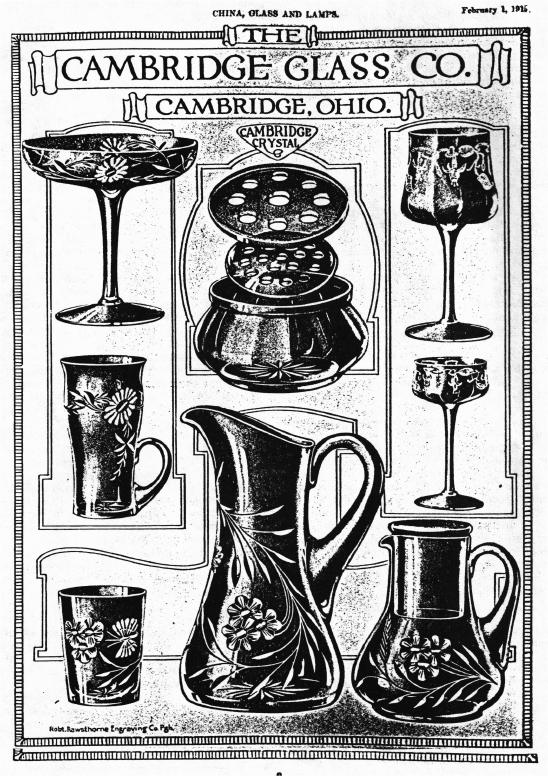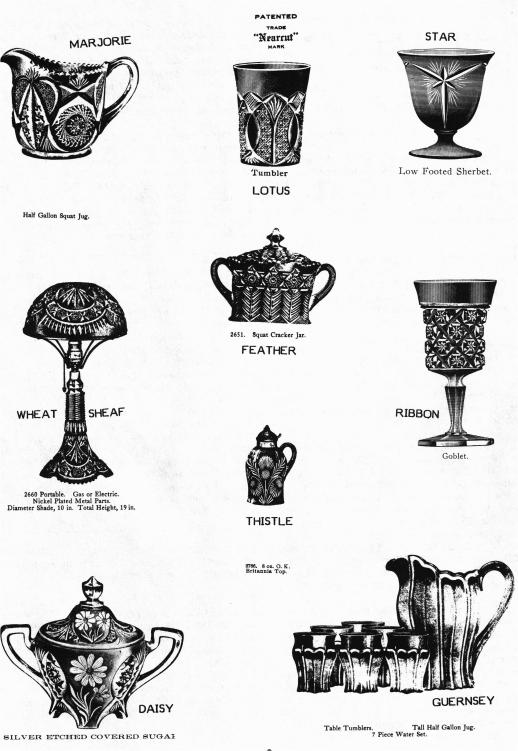"NEARCUT" Patented Trade Mark
Through the eyes of TRADE JOURNAL REPORTERS
by Mark A. Nye
Issue No. 170 - June 1987
Every now and then we all desire to take the "easy way out" but in most instances such is not possible for a myriad of reasons. This month I am going to take, for me at least, what amounts to the "easy way out" method of preparing my monthly article.
Since the theme of this year's convention, to be held later this month, is the Nearcut Era, I thought it might be interesting to examine how the trade journals of those years reported the various lines Cambridge was manufacturing and in the process, provide a brief history of part of the Nearcut years.
From 1906 came the following quotes. The first two originating from China, Glass and Lamps and the third one from Glass and Pottery World. The first is a paid advertisement, while the remaining two were not of Cambridge origin.
"NEARCUT, Our registered trade mark always stamped in the glass. Our "Marjorie" design, NEARCUT, for season 1905 has not yet been equaled in design, brilliancy and finish and remains unequalled as a seller and profit-maker. BUT we shall present an entirely new design for 1906 which is of a novel style of cutting, and which must create a field of its own. It is ORIGINAL, has CHARACTER, and STYLE, and is a success from the start. Compare it with any other and you will buy it. The Cambridge Glass Co., Cambridge O."
"No better booklet has ever been gotten out for the trade than the ten-page illustrated price list devoted to the Lotus line of pressed table ware by the Cambridge Glass Company of Cambridge, Ohio. The dealer is often confused by the many good designs now offered him. The cuts shown of this easy rapid selling line are in excellent taste and have an originality all their own. It is not strange that the ware obtained the highest premium award at the St. Louis World's Fair. "Nearcut" glass "name on every piece" is made exclusively by the Cambridge Glass Company. Manager Bennett, formerly a successful salesman and always resourceful and progressive, puts out a book which you are sure to keep if you get it. It's easy to get and the splendid goods are easy to sell. Plenty of Green Book readers know that to be true."
"Nothing ever caught the buyer's favor any better than the "Near Cut Glass" of the Cambridge (Ohio) Glass Company. That it obtained the highest premium at the St. Louis World's Fair of course helped its prestige. In the Lotus design, originality coupled with quality is most evident. Aquariums and fish-globes are also made here and have some features not to be found at other factories."
Also from Glass and Pottery World come the following, originally published in 1908.
"... The two new table lines of "Near-Cut" pressed glass are a revelation to all visitors. The "Star" design has every appearance of light cuttings and the "Ribbon" pattern closely approaches in detail rich cut glass. It is surely in a class by itself. "Trellis" or "Basket" pattern would better describe its features ..."
" ... calls his ware "near cut". It is mighty "near". The new ribbon pattern that he has a big display of is so very near some cut glass lines that are right up to date that a close look is necessary to discover a difference. Then, there is a Star pattern that is equally deceptive, together with the Wheat Sheaf and Feather cut lines ... "China, Glass and Lamps, January 1908.
From an article in the January 1909 issue of China, Glass and Lamps discussing the Pittsburgh Show comes this selection:
" ... One of the principal features is the new colonial line in pressed ware. The shapes are particularly attractive and present an excellent appearance. (Author's Note: This is the #2892 Guernsey Semi-Colonial Design.) Near them is shown the medium weight imitation cut pattern, with its countless facets from which is reflected the light as though it had only come from the hand of the cutter. Then there is a line of light-weight imitation cutting, also presenting a pleasing appearance and of undoubted durability. One handsome cut punch bowl is the center of attraction because of its imposing appearance and excellence of the work. These things combined with whiskey decanters, jugs, and graceful vases to complete a display that is at once attractive and educational ... "
"The Cambridge Glass Co. never misses a season without something of importance to add to the trade, and this year is no exception. In fact, there are several new things of such beauty and design as to attract more than passing notice. First comes the patented arch foot, imitation cut line with rich crystal effect. It is most complete and reflects the light brilliantly. A vase with two handles, handsome punch bowls, fine designs of exquisite shape, orange bowl, rose bowl and cake stand, all make up a collection unsurpassed in beauty and appearance." This time China, Glass & Lamps tells us about the 1910 Pittsburgh Show and the pattern is #2760 or Daisy.
After the opening of the January 1911 Pittsburgh Show, the Editors of China, Glass and Lamps had, in part, this to say about the Cambridge display.
" ... Another new thing is the Thistle pattern, of which there is a full line. It is very rich in appearance and bears all the marks of the premier factory. The fan-shaped Colonial is another attractive and wonderful creation from the factory, and cannot well be described because of the intricate combination which goes to make up the beauty of the line. The arch-foot design, brought out last year, has been reinforced by some of the prettiest pieces in the entire display. There is combination with the Colonial, made in vases, which appeal at once because of their sparkling beauty and exquisite design ... "
Next we have a paid advertisement, placed by Cambridge in the December 13, 1912 issue of China, Glass and Lamps.
"Our "Near Cut' Brand Tableware and Novelties are well known and established for QUALITY. Extra efforts have been made on this line, and we shall show some very choice new designs for 1913. We now ask you attention to our NEW DEPARTMENT. We are producing a most excellent line of high grade lead blown stemware, tumblers, etc., both in plain, optic, needle etched, deep plate etched and light cut patterns ... "
We end with the China, Glass and Lamps description of the Cambridge display at the January 1915 Pittsburgh Show captioned "Cambridge Glass Co.'s Big Display."
"There is such a wide variety of high class glassware on display in Room 728 at the Fort Pitt Hotel that it is really rather bewildering to make a choice. The Cambridge Glass Co.'s product has always been noted for excellent workmanship, uniform color and close selection and this year's exhibit, which is presided over by W.C. McCartney and L.S. Crain, is no exception to the rule; in fact, if such a thing were possible, it could be said that the present display even exceeds those of previous years.
The popular "Community Colonial' line is there in all its pristine glory with many additions in the shape of novelties and staple items, also the ever popular Nearcut ware.
Numerous new cuttings are noted on the company's high grade paste mold ware. Floral, butterfly and wild rose designs make the ware "Things of beauty and joy forever.' Artistic jugs, nappies, footed stemware, tall comports, etc., greet the eye on every side. There is a large selection of tankards and the fish and peacock jugs giving a rock crystal effect are proving to be very popular.
Special items in guest room sets, jugs and tumblers in a variety of cuttings are shown, together with a line of light cuttings on pressed Colonial ware. Several assortments are shown in a line of plain pressed including bud, grape and vine designs as well as favorite star cuttings. Many novelties in salts and peppers are noted. The deep plate etched fuchsia design is taking well.
Extra slender stems with inward tapering bowls are taking the place of foreign-made ware and the company is making large sales in these lines which have heretofore been imported.
Large lines of blown stemware and tumblers are shown and there is a great variety of needle, plate etching and cuttings. There is also a complete line of paste mold tankards, oil and water bottles, cream and sugar sets, decanters and nappies.
Gas and electric portables, which are in good demand, add greatly to the display by giving an excellent lighting effect, the arrangements of ware being in good taste and very attractive."


